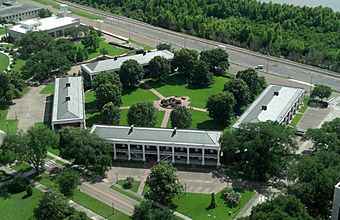Pentagon Barracks facts for kids
Quick facts for kids |
|
|
Pentagon Barracks
|
|
 |
|
| Location | Corner of State Capitol Drive and River Road, Baton Rouge, Louisiana |
|---|---|
| Area | 5.75 acres (2.33 ha) |
| Built | 1819-1825 |
| Built by | John Hill; Capt. Thomas S. Rodgers; Capt. R. D. Richardson |
| Architect | Capt. James Gadsden |
| NRHP reference No. | 73000863 |
| Added to NRHP | July 26, 1973 |
The Pentagon Barracks, also known as the Old United States Barracks, is a group of historic buildings in Baton Rouge, Louisiana. You can find them at the corner of State Capitol Drive and River Road, right on the grounds of the state capitol building.
This important site has a long history. It was used by the Spanish, French, British, Confederate States Army, and United States Army. It was even part of the short-lived Republic of West Florida. Many famous people visited this military post, including Zachary Taylor, Lafayette, Robert E. Lee, George Custer, Jefferson Davis, and Abraham Lincoln.
Contents
Early Forts: French, British, and Spanish Control
Around the year 1700, a French explorer named Pierre Le Moyne d'Iberville visited the Baton Rouge area. France controlled the site until 1763, when the British took over.
In 1779, during the American Revolutionary War, the British built a dirt fort called Fort New Richmond near the Mississippi River. On September 20, 1779, Bernardo de Gálvez, who was the Spanish governor of Louisiana, arrived. He found about 300 British soldiers defending Fort New Richmond.
During the Battle of Baton Rouge (1779), Spanish engineers quickly built a siege line. This allowed the Spanish troops to fire cannons at Fort Richmond. The British surrendered the very next day. After their victory, the Spanish soldiers took control of the fort and renamed it Fort San Carlos.
The Republic of West Florida
American and British settlers who still lived in Louisiana did not like Spanish rule. In 1810, they rebelled and created their own country, called the Republic of West Florida. They flew their special Bonnie Blue Flag over Fort San Carlos during the republic's short life, which lasted only three months.
The Republic of West Florida gave up the city of Baton Rouge to the United States on December 10, 1810.
A U.S. Military Post
American forces renamed the fort the Post at Baton Rouge. This post became a gathering place for American troops. Soldiers assembled here before going to the Creek War in 1813-1814 and the Battle of New Orleans in 1814-1815.
The Army built the Baton Rouge Barracks just north of the old Post at Baton Rouge. In 1819, they tore down the former Fort San Carlos.
United States Army Captain James Gadsden designed the Baton Rouge Barracks. He was in charge of building them from 1819 to 1825. By 1825, the soldiers had finished four two-story brick buildings. These buildings formed four sides of a regular pentagon shape, which is why they were nicknamed the "Pentagon Barracks."
They also built a commissary-warehouse building in 1821. This building was meant to be the fifth side of the pentagon. However, it was poorly built and had to be torn down within a few months. The Pentagon Barracks were large enough to house one thousand troops.
In 1825, the Army also set up a big Baton Rouge Arsenal and Ordnance Depot nearby. This depot supplied weapons and military equipment to the southwestern United States at that time.
The American Civil War
The United States Army used the Baton Rouge Barracks and Arsenal until January 1861. At that time, the State of Louisiana took control of the post. They then gave the arsenal to the Confederate States of America. The Confederacy held Baton Rouge until April 1862, when they left the city during the capture of New Orleans. Union troops then took back and reoccupied the Baton Rouge complex in May 1862.
The Confederates tried to take back Baton Rouge in the Battle of Baton Rouge (1862), but they were not successful. Union leaders renamed the Barracks and Arsenal Fort Williams. This was in honor of Union General Thomas Williams, who was killed in the battle. Union soldiers built dirt walls to protect the complex. They even used an old Native American mound as part of their defenses.
Louisiana State University Campus
In 1884, the Louisiana General Assembly decided that Louisiana State University (LSU) could use all the buildings and grounds of the Pentagon Barracks. The University gained full ownership of the grounds in 1886. The buildings were then used as dormitories, which are like living spaces, for the students. LSU used these grounds until the university moved to its current location in 1926.
A student group called Sigma Iota fraternity was founded there on November 27, 1904. It started as a secret society for Spanish-American students, first called La Colonia Hispano-Americana. Soon after, in December 1904, they changed their name to Sociedad Hispano-Americana.
Modern Use of the Barracks
In 1951, the ownership of the Barracks was given to the State of Louisiana. On July 26, 1973, the buildings were added to the National Register of Historic Places. This means they are recognized as important historical sites.
Today, the Pentagon Barracks still house offices for the lieutenant governor. They also have private apartments for state legislators.




